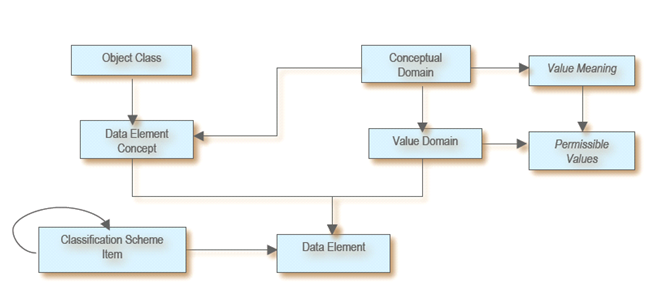Administered Items
An administered item is an item in the OneData registry for which administrative information is recorded. An administration record is a collection of administrative information for an administered item.
Administered items are classified into the following sub-types:
 Classification Scheme.
Classification Scheme. The descriptive information for an arrangement or division of objects into groups based on characteristics that the objects have in common.
A classification scheme has a classification scheme type (for example, taxonomy or keyword), and is made up of classification scheme items (CSI), which may be hierarchical. A CSI is an item of content in a classification scheme.
The CS-CSI pair may be associated with zero or more administered items, and an administered item may be associated with zero or more CS-CSI pairs. CSI Items can be either self recursive or network recursive, depending on your business needs.
 Concept
Concept. A logical grouping of related administered items, value meanings, or classification scheme items. Concepts can be logically deleted. For more information, see
Implementing webMethods OneData.
 Conceptual Domain
Conceptual Domain. A set of valid
value meanings, which are the meanings or semantic contents of a value.
 Context
Context. A universe of discourse in which a name or definition is used.
 Data Element
Data Element. A unit of data that (in a certain context) is considered indivisible. A data element is uniquely identified by its preferred name, preferred context, and version number. A data element is conceptually identified by its data element concept, and is represented by its value domain.
The following table provides a list of derivation types.
Derivation Type | Derived Data Element | Sub Data Elements | Description |
Compound | Mailing Address | Street Address
City
State
Zipcode | Group of data elements with a display order. |
Concatenation | Telephone Number | Phone Area
CodePhone
ExchangePhone
Instrument | Group of data elements with a display order and concatenation character. |
Object Class | Person | Person ID
Person First Name
Person Last Name
Person Age
Person Sex | Group of data elements with optional methods. |
Calculated | Person Annual Salary | Person Weekly Salary | Data elements with a derivation rule (for example, PAS = PWS * 52) |
Recoded | Employment Indicator | Person Age
Worked Last Week
Seeking
Employment | Data elements with a complex derivation rule (for example, EI=Yes when Age >=15 and Worked Last Week = Yes). |
 Data Element Concept
Data Element Concept. The idea or perception of a data element. Data element concepts consist of an object class and a property, conceptually representing a single unit of data. Data element concepts are useful for grouping similar data elements, and may be used in a process for harmonizing data elements.
 Derivation Rule
Derivation Rule. The logical, mathematical, and other operations specifying derivation.
 Object Class
Object Class. A set of ideas, abstractions, or things in the real world that are identified with explicit boundaries and meaning and whose properties and behavior follow the same rules. It is much like an entity in relational terms (for example, person, airport, aircraft, facility).
 Property
Property. A characteristic common to all members of an object class. It is much like an attribute in relational terms, with the important exception that a property does not have a specified representation (for example, elevation, location, ID, first name, last name, address).
 Representation Class
Representation Class. The classification of types of representations.
 Value Domain
Value Domain. Establishes the set of
permissible values that can be used to represent a data element. Permissible value is an expression of a value meaning allowed in a specific value domain.
For more information about administered item sub-types, see
Administered Item Sub-Types Attributes
and Child Entities.
The following diagram depicts the relationships among administered item types.
